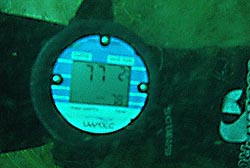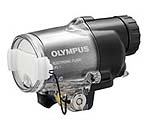« My other passion | Main | Body fat, body composition report, and diving »
June 19, 2007
Underwater cameras without cases
Taking pictures underwater continues to fascinate me and I wish I had more opportunity to do so. Olympus spends a lot of money on their underwater camera gear and I made a proposal to them to do a full feature on their entire lineup, sort of an informational promo piece they could use to highlight and explain their products to customers. Sadly, the proposal was circulated back and forth but nothing ever came of it.
Anyway, having had the chance to take very different kinds of cameras on dive trips, I am now convinced that picking the right camera to take with you on a dive trip is even more important than picking the right camera on a land assignment. On land, the emergence of inexpensive, powerful, yet impossibly small and slender digital cameras means you can take excellent high-res pictures anywhere. The camera never gets in the way. For serious shooting you want a digital SLR, and those are a lot larger and bulkier and that generally means a carry case for all the accessories and so on.
All of this is multiplied underwater where we're already busy and loaded down with gear. In the beginning just remembering what to do in order to stay alive pretty much takes up all discretionary time and brain cells. Later on, as we become more comfortable in this foreign environment, bringing a camera along becomes possible and lots of fun. Yet, that means picking one that's suitable for underwater photography and then the investment not only in the camera, but also its underwater case and whatever other gear it needs. That can easily meet or exceed the cost of the camera itself even with the simple deepwater cases for point & shoot compacts. Add up the needed gear for a digital SLR, and we're talking several thousands of dollars.
Apart from the cost, a camera suitably protected for underwater duty is a lot larger and bulkier. A slender compact becomes a brick, and a SLR a rather massive contraption, especially when you add the almost always necessary external flash. So a dive really becomes a dedicated photography dive. Nothing wrong with that, but maybe there is. These days we simply expect to have a small camera along wherever we go, just in case. I almost always have one in my pocket, next to my cellphone. And soon the cameras in cellphones may be good enough that even that is no longer necessary. Never count out the greed of the telcos that make it nearly impossible to simply send a picture without signing up for expensive extra services and idiotic proprietary interfaces, but it may happen.
Anyway, point is that I'd like to take a camera with me when diving without having to worry about it. No bulk, no case, no fuss. And Olympus is blazing the trail here with the awesome Stylus 770SW, the 3.5 x 2.25 x 0.75 inch 7-megapixel wonder that you can take diving without a case. I wrote about it before, marveling that you can take it way deeper than its rated 33 feet. I took it down to 67 feet in the duckweed-covered Catfish Hotel sinkhole in Florida's Manatee Springs state park. Its built-in depth meter stopped at 33 feet and the little camera protested, but kept on working. Water pressure pushed in some buttons so that functionality was a bit impaired by flashing and beeping at greater depths, but it never missed a beat and no leaks.
 So last weekend Carol took another Olympus 770SW with her as she conducted checkout dives for an advanced NAUI class at the Loch Low Minn quarry in Tennessee. She wasn't very familiar with the camera yet and most of her attention was on her students as they did the deep dive part of their advanced class curriculum. The quarry is about 80 feet deep and the bottom was pretty murky with visibility down to 10-15 feet, if that. So no pretty pictures this time, but the 770 saw a depth of 77 feet. In fact, the picture above was taken with it.
So last weekend Carol took another Olympus 770SW with her as she conducted checkout dives for an advanced NAUI class at the Loch Low Minn quarry in Tennessee. She wasn't very familiar with the camera yet and most of her attention was on her students as they did the deep dive part of their advanced class curriculum. The quarry is about 80 feet deep and the bottom was pretty murky with visibility down to 10-15 feet, if that. So no pretty pictures this time, but the 770 saw a depth of 77 feet. In fact, the picture above was taken with it.
How did it do? According to Carol, the buttons on this one didn't get pushed in by water pressure and all controls worked even at nearly 80 feet. What did happen was that the water pressure apparently pushed in the glass of the LCD enough to cause a black rectangle in the center of the 2.5-inch display. It disappeared as she ascended and the camera was none the worse for wear. And no leakage either. That's just amazing.
Does this mean cameras like the Olympus 770SW will replace bulky underwater cases for compacts? Maybe. If the 33-foot-rated 770 can be taken down to almost 80 feet and still work, it's probably possible to make one that can handle the recreational diving depth limit of 133 feet. And with Olympus already having taken the big step from 10 feet with their Stylus 720SW to 33 feet with the Stylus 770, I wouldn't be surprised to see the next one rated at 66 feet (which means we'd take it to 133).
Are there other issues? Yes. It can get cold down there and that may mean gloves. Carol said it was difficult to operate the tiny little buttons on the 770 SW with gloves on. Deepwater cases always have those big plastic pushbuttons that are much easier to operate with gloves. It also gets darker the deeper you go, and reading all those tiny icons and writing that already virtually impossible to decipher in bright sunlight on the surface becomes next to impossible. No problem if you really know your camera, but with a mask on and bubbles around your head and other things vying for your attention, nice large and readable labels come in handy.
 Anyway, I am just thrilled with what Olympus has done with the 770 SW. But what about flash, you may ask. Built-in flashes are generally useless for anything but macro photography underwater due to "scatter," i.e. the flash illuminating all the stuff that always floats around in water instead of the subject. Well, that can be fixed by having an external flash, and Olympus just introduced the UFL-1 Underwater Strobe, rated for 133 feet. It's a slave flash which means it does not require a cable connection to the camera. Very cool, and I can't wait til I get to try one out.
Anyway, I am just thrilled with what Olympus has done with the 770 SW. But what about flash, you may ask. Built-in flashes are generally useless for anything but macro photography underwater due to "scatter," i.e. the flash illuminating all the stuff that always floats around in water instead of the subject. Well, that can be fixed by having an external flash, and Olympus just introduced the UFL-1 Underwater Strobe, rated for 133 feet. It's a slave flash which means it does not require a cable connection to the camera. Very cool, and I can't wait til I get to try one out.
Posted by conradb212 at June 19, 2007 11:14 PM








